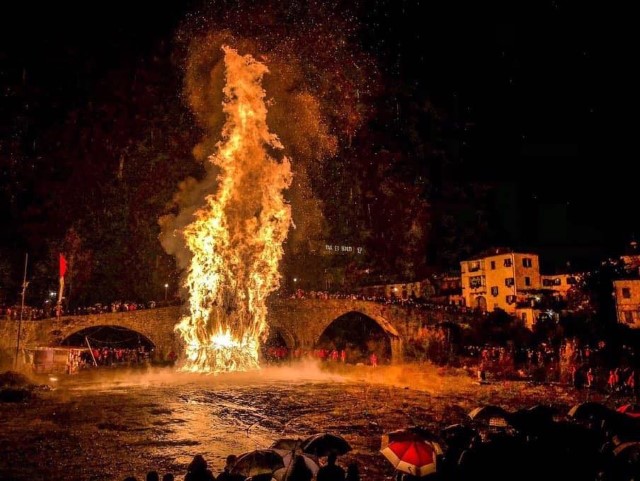
January in the Lunigiana is synonymous with the Pontremoli Bonfire Challenge, the never-ending competition between the white & blue flagged contrada of San Nicolò and the white & red flagged contrada of San Geminiano. The former light their fire on the evening of January 17th near Ponte “Pompeo Spagnoli” at Porta Parma, whilst the latter light their fire on January 31 (the saint day of San Geminiano, patron saint of Pontremoli) to the South side of Ponte della Cresa.
There is a third bonfire event in Pontremoli – that dedicated to Sant’Ilario (St Hillary) and held on 13th January. This is a much smaller affair than the other two and is located in the shadow of the Piagnaro Castle on its Western side.
Elsewhere in the upper Lunigiana, bonfires are also constructed in honour of Sant’Antonio Abate, patron saint of farm animals. On the evening of January 16, two fires are lit in Filattiera (one near the entrance to the village, and another near the votive shrine at Volpino) whilst on 19 January a bonfire in Mulazzo is set ablaze.
Bonfire construction
The San Geminiano blog reveals that their bonfire is generally 11 to 13 meters high, depending on the weather conditions on the day it is set alight, with a base circumference of 20-25 meters. It is made up of thin, very dry shrubs (specifically wild heather – otherwise called “ulso” – supplemented by broom & brambles). The stokers start cutting the shrubs in the Pontremolese woods the previous September, and store their hoard in locations known to provide excellent drying conditions. These are kept secret to avoid sabotage (fires, theft or other destructive action) by the opposing contrada. The “bochi” (as the shrubs for the bonfire are referred to in dialect, a legacy of when the fire was made almost exclusively of brambles and thorny plants as timber was retained by the owners of the woods for domestic consumption) are arranged around a framework of chestnut or acacia poles, which act both as as support for the fire and as a chimney for drawing air at the moment of ignition, when the flame must develop upwards. Tradition has it that, apart from fixing the poles, no mechanical means must be used to raise the bonfire which must be monitored by stokers day and night until it is ignited. For this reason, a small refuge is always constructed near the site, primarily to provide shelter and warmth for all those involved in the construction, but also to provide a social space for visiting members of the contrada.